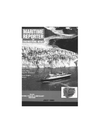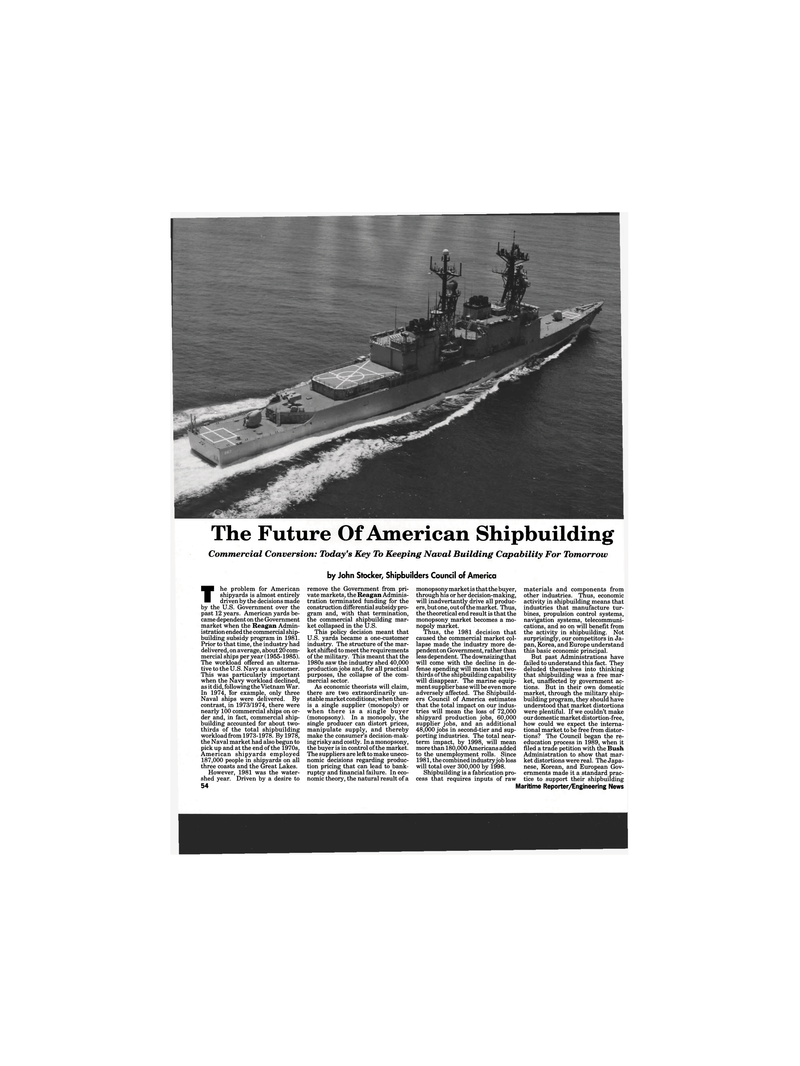
Page 54: of Maritime Reporter Magazine (July 1993)
Read this page in Pdf, Flash or Html5 edition of July 1993 Maritime Reporter Magazine
The Future Of American Shipbuilding
Commercial Conversion: Today's Key To Keeping Naval Building Capability For Tomorrow by John Stacker, Shipbuilders Council of America
The problem for American shipyards is almost entirely driven by the decisions made by the U.S. Government over the past 12 years. American yards be- came dependent on the Government market when the Reagan Admin- istration ended the commercial ship- building subsidy program in 1981.
Prior to that time, the industry had delivered, on average, about 20 com- mercial ships per year (1955-1985).
The workload offered an alterna- tive to the U.S. Navy as a customer.
This was particularly important when the Navy workload declined, as it did, following the Vietnam War.
In 1974, for example, only three
Naval ships were delivered. By contrast, in 1973/1974, there were nearly 100 commercial ships on or- der and, in fact, commercial ship- building accounted for about two- thirds of the total shipbuilding workload from 1973-1978. By 1978, the Naval market had also begun to pick up and at the end of the 1970s,
American shipyards employed 187,000 people in shipyards on all three coasts and the Great Lakes.
However, 1981 was the water- shed year. Driven by a desire to 54 remove the Government from pri- vate markets, the Reagan Adminis- tration terminated funding for the construction differential subsidy pro- gram and, with that termination, the commercial shipbuilding mar- ket collapsed in the U.S.
This policy decision meant that
U.S. yards became a one-customer industry. The structure of the mar- ket shifted to meet the requirements of the military. This meant that the 1980s saw the industry shed 40,000 production jobs and, for all practical purposes, the collapse of the com- mercial sector.
As economic theorists will claim, there are two extraordinarily un- stable market conditions; when there is a single supplier (monopoly) or when there is a single buyer (monopsony). In a monopoly, the single producer can distort prices, manipulate supply, and thereby make the consumer's decision-mak- ing risky and costly. In a monopsony, the buyer is in control of the market.
The suppliers are left to make uneco- nomic decisions regarding produc- tion pricing that can lead to bank- ruptcy and financial failure. In eco- nomic theory, the natural result of a monopsony market is that the buyer, through his or her decision-making, will inadvertantly drive all produc- ers, but one, out of the market. Thus, the theoretical end result is that the monopsony market becomes a mo- nopoly market.
Thus, the 1981 decision that caused the commercial market col- lapse made the industry more de- pendent on Government, rather than less dependent. The downsizing that will come with the decline in de- fense spending will mean that two- thirds of the shipbuilding capability will disappear. The marine equip- ment supplier base will be even more adversely affected. The Shipbuild- ers Council of America estimates that the total impact on our indus- tries will mean the loss of 72,000 shipyard production jobs, 60,000 supplier jobs, and an additional 48,000 jobs in second-tier and sup- porting industries. The total near- term impact, by 1998, will mean more than 180,000 Americans added to the unemployment rolls. Since 1981, the combined industry job loss will total over 300,000 by 1998.
Shipbuilding is a fabrication pro- cess that requires inputs of raw materials and components from other industries. Thus, economic activity in shipbuilding means that industries that manufacture tur- bines, propulsion control systems, navigation systems, telecommuni- cations, and so on will benefit from the activity in shipbuilding. Not surprisingly, our competitors in Ja- pan, Korea, and Europe understand this basic economic principal.
But past Administrations have failed to understand this fact. They deluded themselves into thinking that shipbuilding was a free mar- ket, unaffected by government ac- tions. But in their own domestic market, through the military ship- building program, they should have understood that market distortions were plentiful. If we couldn't make our domestic market distortion-free, how could we expect the interna- tional market to be free from distor- tions? The Council began the re- education process in 1989, when it filed a trade petition with the Bush
Administration to show that mar- ket distortions were real. The Japa- nese, Korean, and European Gov- ernments made it a standard prac- tice to support their shipbuilding 56 Maritime Reporter/Engineering News

 53
53

 55
55
